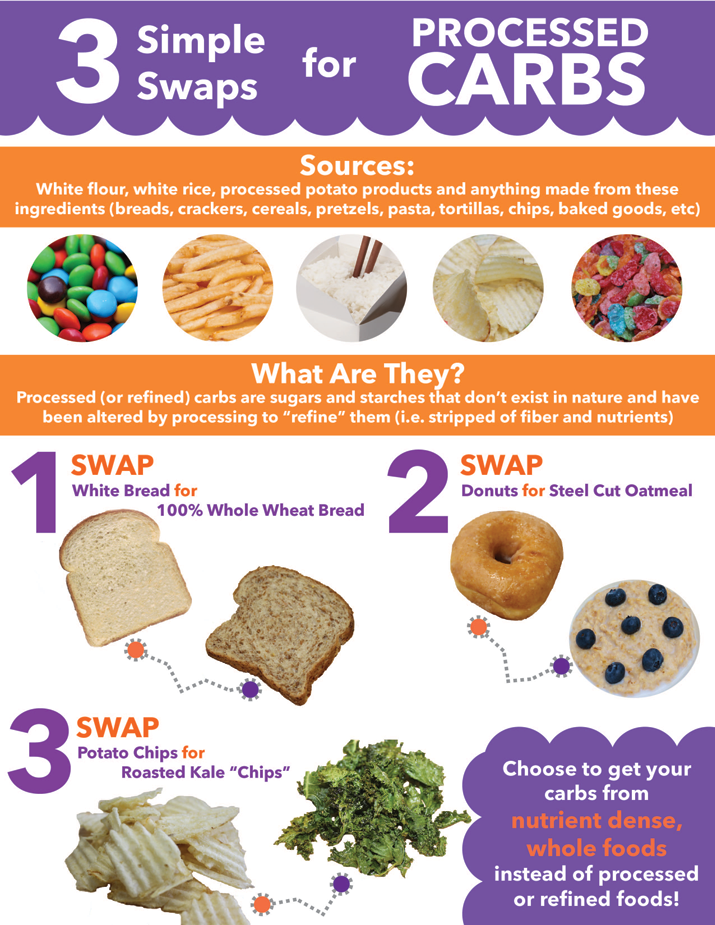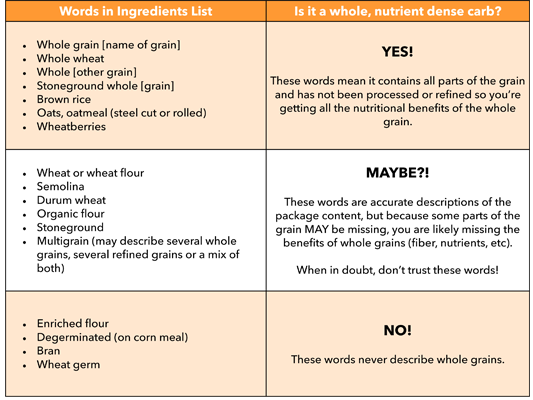“Everywhere modern processed foods go, chronic diseases like obesity, type 2 diabetes and heart disease soon follow.” -Kris Gunnars
The typical American diet is inundated with highly processed carbohydrates. We have a bagel made from white flour and sugar for breakfast, a sandwich on white bread for lunch, potato chips for snack, white pasta with dinner, cake and ice cream for dessert…I could go on and on.
Carbohydrates are Not Created Equally
All carbohydrates provide energy in the form of glucose, but the rate at which they are digested and utilized by the body varies greatly.
Nutrient dense, unrefined carbohydrates are:
- Sugar and starches that exist in nature (whole fruits and vegetables, beans, intact grains, etc) and have not been processed or refined
- Naturally high in fiber (helps regulate glucose and insulin levels and keep you fuller longer)
- Full of vitamins, minerals, and protein
Processed carbohydrates (otherwise known as refined carbohydrates) are:
- Sugar and starches that do not exist in nature and have been altered in some way through processing techniques to “refine” them
- Low in fiber
- Low in vitamins, minerals and protein
- Considered “empty” calories due to low nutrient content
The more a carbohydrate is processed, the less fiber and nutrients it contains. When eaten in excess, processed carbs can wreak havoc on our blood sugar, insulin and energy levels (just like sugar does!).
These foods are digested very quickly, resulting in a rapid spike (and equally rapid crash) in blood glucose levels. These glucose swings can contribute to overeating, unwanted weight gain, irritability, mood swings, etc.
Where Do You Find Processed Carbs?
Almost everywhere! Most foods that come in a package will likely contain processed carbohydrates (of course, there are some exceptions but you’ll have to look a little harder to find these gems).
Processed carbs include white flour, white rice, processed potato or corn products and anything made from these ingredients (breads, crackers, cereals, pretzels, pasta, tortillas, chips, etc.). And don’t forget candies, sweets, and sodas!
What to Look For
Many foods with healthy sounding names are in fact highly processed with little nutritional value. Take a closer look at that “multi-grain” bread or cereal “made with whole grains.”
Make sure to look for the word “whole” before any flour ingredient on the ingredients list (ex. whole wheat flour versus wheat flour) to ensure you’re getting the full nutritional value of the unrefined, intact grain.
The table below from the Whole Grains Council is a great guide to help get you started.
Choose Nutrient Dense Carbs Instead
Our great-great grandparents knew what potatoes were but they probably would’ve been a little leery of potato chips, tater tots or potato flakes in a box (and rightly so!). Give these nutrient dense carbohydrates a try:
- Intact grains: quinoa, brown rice, millet, wheat berries, spelt berries, amaranth, kaniwa
- Steel cut oats, rolled oats and other 100% whole grain cereals
- Products made from 100% whole grain flours (breads, pasta, etc.---no sugar added of course!)
- Whole potatoes, any type, with skin (not fried)
- Whole corn, corn on the cob, corn kernels
- Beans and lentils
- Winter squash (butternut, acorn, etc)
- Whole fruit (limit to 2 servings per day)
- Unsweetened dairy (milk, yogurt, cheese)
Kale Chips
Makes 4 servings
These crispy, roasted kale chips are a great swap out for potato chips! They’re great as a snack or a side dish or even as a healthy appetizer for gatherings and parties.

Ingredients
1 bunch of kale, washed and dried thoroughly, stems removed
1 Tbsp olive oil
Salt and pepper, to taste
Optional Seasonings: cumin, red pepper flakes, lemon juice, etc,
Directions
- Preheat oven to 350⁰F.
- Wash and thoroughly dry kale, removing the stems. Chop or tear kale leaves into bite-sized pieces.
- Toss with olive oil, salt and pepper until coated. You can use other seasonings depending on your taste preferences such as cumin or red pepper flakes.
- Line a baking sheet with aluminum foil. Place seasoned kale in an even layer on baking sheet.
- Bake 10-12 minutes, or until crisp, turning halfway through.
- Serve immediately.




3 Comments
I love to make the Kale Chips. I put Weber's Garlic and Herbs on mine - YUMMY!
Do you have information or advice about cassava flour? Is it a good substitute for white flour? It seems like it is a whole food, rather than refined, but I would like your opinion.
Cassava flour would be nutritionally superior to white flour but comparable to whole wheat flour and other grain-free flours (brown rice, almond, etc.). Quality will vary so I'd always double check ingredient lists but if you're looking for a grain-free flour substitute, you can give it a try. It does have a little higher carbohydrate content though since it's from a starchy root vegetable.